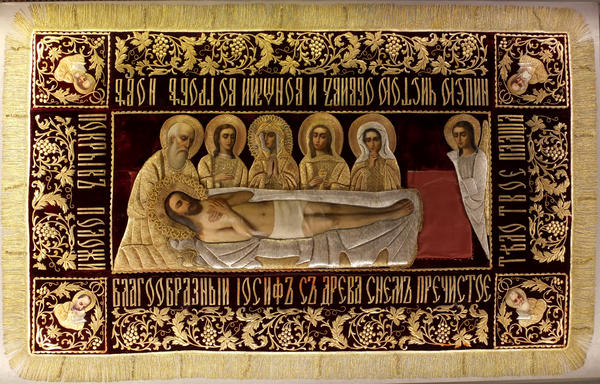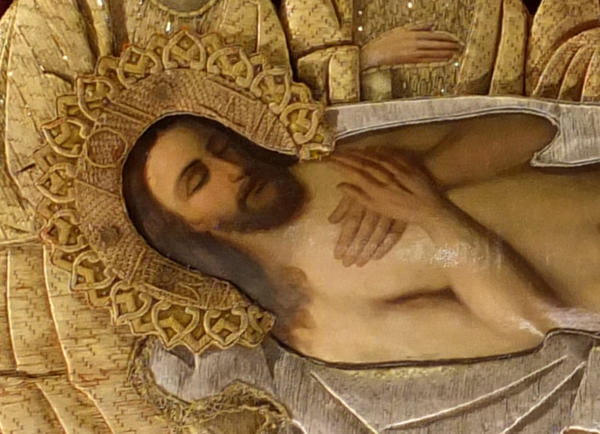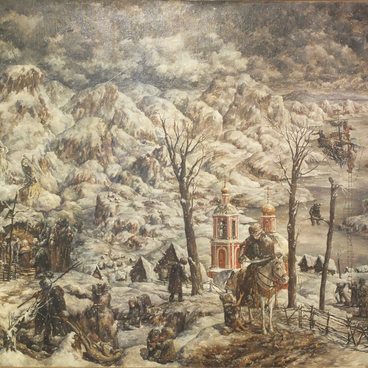he shroud Placement in the sepulcher is a picturesque version of the Shroud of Turin which, as the legend has it, the body of Christ was wrapped into. The ancient relic in the form of a four-meter linen cloth is kept with the Cathedral of John the Baptist in Turin. It has imprints on it resembling contours of a human body and face. The Catholic Church does not recognize this shroud as a genuine one; however, it is honored as a reminder about earthy sufferings of Christ. The Russian Orthodox Church didn’t articulate an official standpoint as to the authenticity of this shroud.
Shroud Placement in the sepulcher
Время создания
Beginning of the 20th century
Размер
119x187 cm
103х171 cm (without fringe); 119х187 cm (with fringe).
103х171 cm (without fringe); 119х187 cm (with fringe).
Техника
Velvet, satin, felt, laid embroidery, pillow lace
Коллекция
Выставка
1
Открыть в приложении#1
Unknown Author
Shroud Placement in the sepulcher
#2
#3
Shroud of Turin, Cathedral of John the Baptist in Turin Source: wikipedia.org
#4
The shroud from the collection of the Uglich Museum was created in early 20th century in the traditions of past centuries. In the center of the canvas, in the centerpiece, is a multi-figure composition Placement in the sepulcher. The naked body of Christ with a waist cloth is enshrouded with funeral fabrics. Jewish elder Joseph of Arimathea had already placed him into the sepulcher — Jesus was buried in his sepulcher. Over Christ, there are the Virgin of Anguish, Apostle John the Evangelist, first witness of Resurrection Maria Magdalena and Maria of the Joseph. Behind their backs is an angel that was present during the funeral.
#5
Enlarged image of Christ taken from the shroud
Source: State Autonomous Institution of Culture of Yaroslavl Region “Uglich Historical, Architectural and Art Museum
The figure of Christ and the faces of the saints and the angel are painted with oil paints, while the landscape — other images on the shroud — are embroidered with metal threads of golden color.
#6
On the fields a mandatory text is embroidered: “Well-beseen Joseph, having unhooked from the cross Your Blessed body, wrapped in a shroud and anointed with odors, and placed in a new sepulcher”. This brief worship song, troparion that reveals the meaning of Holy Saturday — a feast when Christians recollect the funeral of Christ.
The shroud is brought out to the middle of the cathedral on Holy Friday during the Holy Week. The Holy Week precedes Easter; during that week Christians recollect the events of the last days in the life of Christ. The carrying out of the shroud is a relatively young tradition: earlier on Friday a Gospel book covered by a small scarf bearing an image of dead Jesus was carried out. Thus it was demonstrated that Jesus was lying in the sepulcher and his soul sank into the hell.
Approximately in the 16th century one started using a big cloth instead of the scarf which is now called shroud. Initially it was kept on the holy table of the altar throughout the Easter week and afterwards one started leaving it until the feast of the Ascension of Christ that is celebrated on the 40th day following the Easter. The tradition to carry out the shroud — the Holy Sepulcher — for believers to worship — eventually took a foothold no sooner than in the 17th century, while already by the 19th century it was enshrined into the contemporary clerical discipline.
#7
State Autonomous Institution of Culture of Yaroslavl Region “Uglich Historical, Architectural and Art Museum
читать дальшескрыть
00:00
00:00
1x
Shroud Placement in the sepulcher
Время создания
Beginning of the 20th century
Размер
119x187 cm
103х171 cm (without fringe); 119х187 cm (with fringe).
103х171 cm (without fringe); 119х187 cm (with fringe).
Техника
Velvet, satin, felt, laid embroidery, pillow lace
Коллекция
Выставка
1
Открыть в приложении
Поделиться





